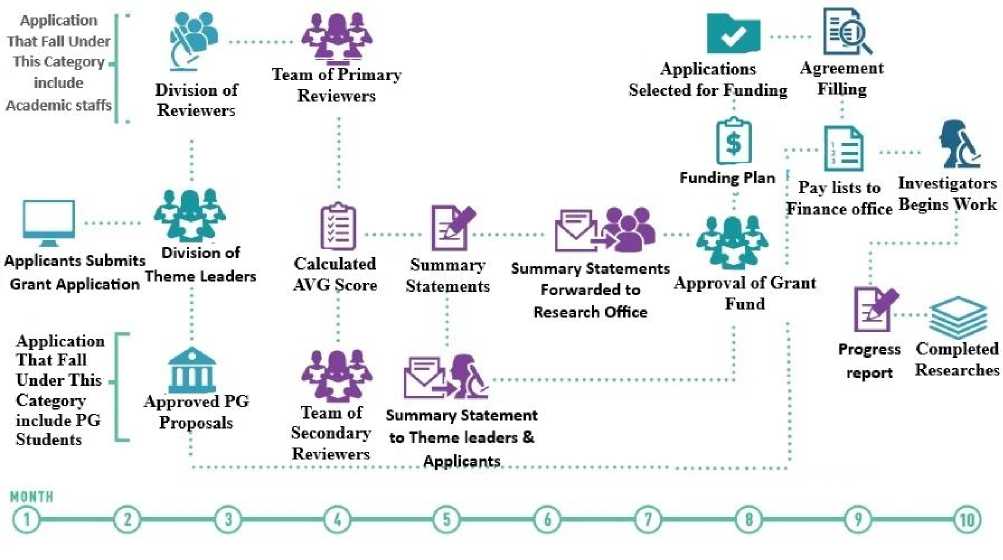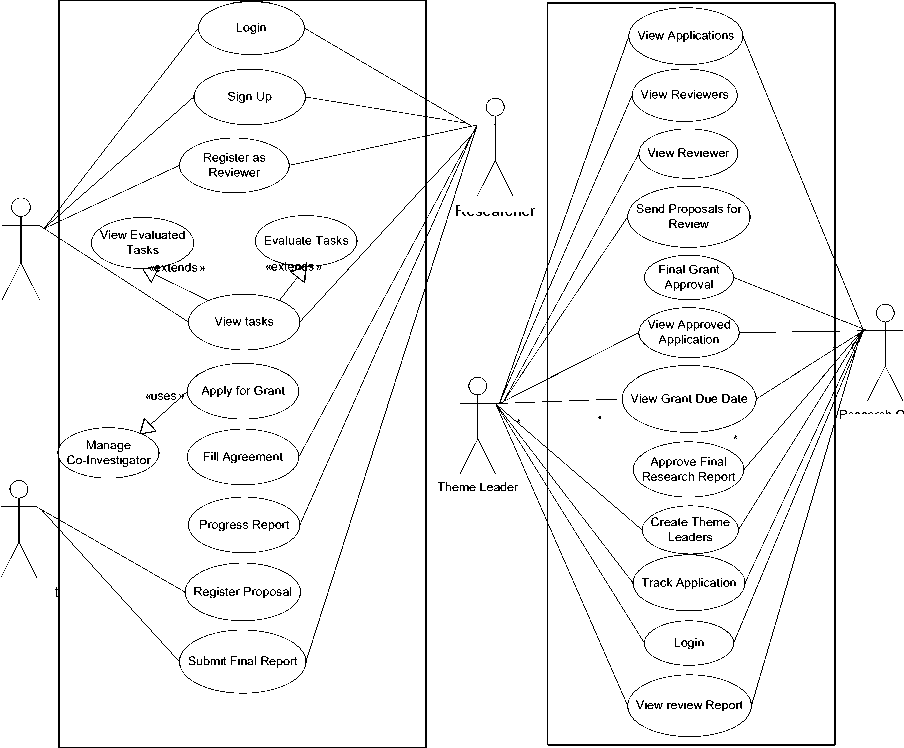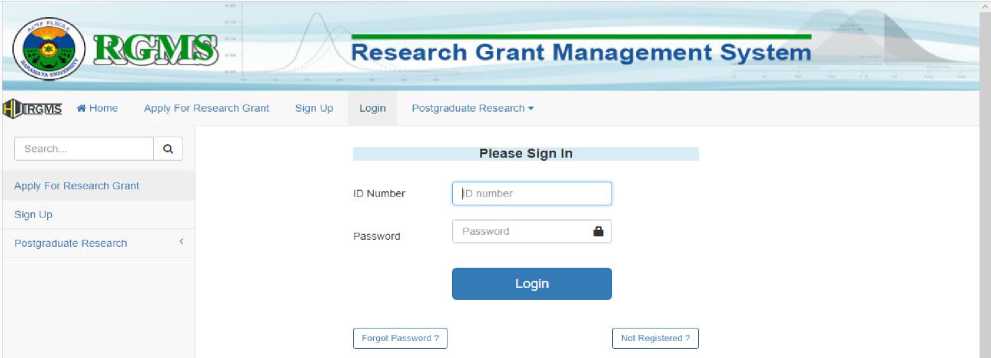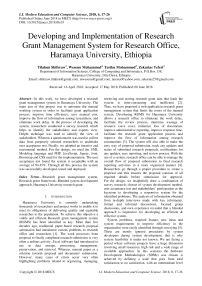Developing and implementation of research grant management system for research office, Haramaya university, Ethiopia
Автор: Tilahun Shiferaw, Wesenu Mohammed, Tariku Mohammed, Zekarias Teferi
Журнал: International Journal of Modern Education and Computer Science @ijmecs
Статья в выпуске: 6 vol.10, 2018 года.
Бесплатный доступ
In this work, we have developed a research grant management system in Haramaya University. The main aim of this project was to automate the manual working system in order to facilitate grant application process, improve time efficiency, save manual cost, improve the flow of information among researchers, and eliminate work delay. In the process of developing the system, researchers conducted a survey research which helps to identify the stakeholders and experts view. Delphi technique was used to identify the view of stakeholders. Whereas a questionnaire was used to collect data from purposely selected researchers to undertake user acceptance test. Finally, we adopted an iterative and incremental method. For the design, we used the UML Modeling language and PHP, JavaScript, Jquery, Json, Bootstrap and CSS used for the implementation. The user acceptance test found the system is acceptable with an average of 94.45%. Through all this process the system was successfully developed, tested and deployed.
Research grant management system, Research grant framework, Blended system development approach, Haramaya University research grant
Короткий адрес: https://sciup.org/15016769
IDR: 15016769 | DOI: 10.5815/ijmecs.2018.06.03
Текст научной статьи Developing and implementation of research grant management system for research office, Haramaya university, Ethiopia
Published Online June 2018 in MECS DOI: 10.5815/ijmecs.2018.06.03
-
II. O BJECTIVES OF THE S YSTEM
The aim of the paper is to quantify the importance of automated electronic grant management system for organizations having complex work process and emphasizing the approaching to be followed during development of applicable systems.
-
A. General objectives
The main objective of the study is to develop the research grant management system for Haramaya University.
-
B. Specific objectives
V To convert the current paper-based research grant proposal submission and approval process into a system to system submission and electronic approval routing process
V To minimize wastage of time in the current manual working system
V To supply the archive with the electronic and digital resource management system
-
V To enhance proposals progress tracking for reporting and management
-
V To show blended system development approaches
-
III. M ETHODOLOGY
Delphi iteration processes were determined continuously to achieve the desired goal. Accordingly needed information is gathered and reached on consensus in most cases. Two round-table discussions appropriately as follows, in round 1: participants were provided with a set of proposed system features and possible futures of the proposed modules and requested to identify system business processes and core system functionalities for the proposed research grant management system. They are also requested to itemize any additional functionality and features that they felt should be considered along with justifications. In the 2nd round, participants were provided with a set of revised core functionalities, modules and features of the system for further review, and requested to rank. Moreover, structured questionnaires for 20 software developers and system analysts and 40 researchers were involved to select system development method and conduct system acceptance test. Furthermore, own experience as a subtheme leader of computing and information technology for more than 3 years was also helpful in substantiating information obtained through different data.
-
IV. R ESULTS AND D ISCUSSIONS
The study adopted a two rounds Delphi technique. In the first round of the Delphi technique, participants were provided with a set of required roles and features/functionalities of the system that must be fulfilled and requested to identify core features/functionalities and major stakeholders with their roles. They were also invited to add new functionalities along with justifications. Accordingly, 32 functionalities/roles were identified and prepared for the second round for research group directorate director to revise and rank the must needed features/functionalities of the system. Subsequently, we developed a framework (see fig. 1.) to properly design and develop the system.

Fig.1. The proposed research grant management system framework
-
A. Proposed Framework of the system
Postgraduate students use the system to register their proposals, after that research office processes funding. Finally, they have to submit their research report for clearance.
-
B. Use case diagram
Based on the framework, the system designers draft the business logic and categorized the system features into five basic modules such as researchers, theme leaders, reviewers, research officer and postgraduate students. Required roles of researcher, reviewer, theme leader and research officer depicted by the panel of experts were indicated as the use case in Fig. 2. below.
Reviewer

Researcher
Theme Leader
Research Officer
PG Student
Fig.2. Identified actors of the system with their activities/actives
-
C. User Interface Description
The user interface was remodified after user acceptance test. So that all research communities of Haramaya University must register by using their university ID after providing all required information the system automatically generates user password then a user can change or modify their password for security purpose.
Once users registered to the system, they can log in to the system through privileges-based login and will provides with privileges-based menu through which they can access the system.

Fig.3. Researchers community login interface
When registered as a researcher to apply for a research grant, one needs to move to the left sidebar and click a drop-down menu “apply for research grant” that has a drop-down menu of research grant types (regular, women’s, innovative and knowledge transfer) at Haramaya University. When a user clicks on one of this category, an application form will be displayed. After filling all required proposal submission information and click on submit button, the system automatically generates a project id like HUKT_2018_05_02_27 which indicates university, year, type of grant, theme number, sub-theme number and two-digit random number. Then click next button to add involved co-investigators and students. Once researchers completed filling of the form the system automatically generates application summary in pdf form that to download. In case if there need to add or delete involved co-investigators in a particular project it is possible by using Manage co-investigator menu. Any researcher can apply as a reviewer in any sub-themes by navigating to the left sidebar and click on “register as reviewer” link but it is theme leaders to approve reviewer’s application. The other greatest feature of the system is tracking research status of each project that applied and completed projects involved as principal and co-investigator in summarized table form having the information of project ID, title, investigators start and end date, budget and status/progress. The researcher can fill an agreement form by clicking on “agreement” link when the final approval is made by the research officer. Once project work is started the researcher should frequently send a project report through “progress report” link. Finally, after completion of the project work, the researcher can submit his final report including final research report, manuscript and policy brief using “submit final report” link. Notification of any updates and news, profile update, and private messaging service is developed for all types of users.

Research Grant Management System
Apply for Research Grant
Welcome to Researchers Page
Register as Reviewer
Manage Co-investigators
Researchers: are the largest group of users for this system. Any individual with a researcher role can do many activities starting from grant application to final project report submission, some of these activities are
Track Projects
Agreement
Progress Report
Submit Final Report
-
• Apply for a research grant under different grant categories: - such as regular, women, innovative and knowledge transfer. The project code(id) will appear at the top front of the same page immediately after submission of the first grant application phase. This project code is very crucial for the rest of any other activities. Therefore, you have to keep it in a safe and secured place. It is possible to apply one or more project per grant season. After completion of the application process one can download a report in pdf format which consists detail of the application.
-
* Register or apply as a reviewer in different theme and subthemes: - Though this theme or subtheme should be found in the domain of your study area. You can also apply more than once for each theme and subtheme. Your application as a reviewer will be accepted or rejected by the concerned Theme leader.
Fig.4. Researchers’ working interface
Theme leaders are immediate supervisors who control every activity under their theme. First, a theme leader can view grant application under his/her theme through “view applications”. Reviewer applicants get approval or termination by the theme leader via “reviewer applicant” link and also, he/she can see approved review list by clicking on “approved reviewers” link. A theme leader can send proposals for respected reviewers to be evaluated by them through “send proposals to reviewers” link. Also, the evaluated proposals with their respective individual and average mark results both for primary and secondary screening can be accessible by the theme leader on “Evaluation result” and “Average Result” links respectively. Besides a theme, leader can track and view the list of researchers who passed the primary screening, secondary screening, approved for the fund, on progress and completed grants under his/her theme via “track applications” link and also it is possible to download this reports for further processing both in pdf and excel format. Likewise, he/she can also see the researcher's progress report under his/her theme on “progress report” link. Lastly, a theme leader can apply for a research grant and act as a researcher without leaving his theme leader account via” apply for research grant” link.

View Applications
Reviewer Applicants
Approved Reviewers
Send Proposals to Reviewers
Evaluation Result
Average Result
Reviewed Proposals
Track Applications
Progress Report
Apply for Research Grant
Research Grant Management System

Welcome to Theme Leaders Page
Theme leader can assign reviewers, in order to determine reviewers for the proposal, the theme leader can search through the iist of reviewers in their theme/subtheme of interests in the profile, or their names. TL has a responsibility to manage all submissions. The TL also has the capability to view all the proposals in histheme. The system provides the function to the TL to export all proposals stored in the system as an excel file. Tables contain all proposals submitted to our system as well as their status, submitted author and date submitted.
Fig.5. Theme leaders’ page
To play a reviewer role, the account must be activated by the theme leader. After login, the reviewer can view assigned tasks for both primary and secondary screening from “view task” link. To evaluate the assigned proposals, he/she have to click on “evaluate tasks” link. Also, the evaluated tasks will be visible on the “view evaluated tasks” link. Next, to this, the reviewer can apply to be a reviewer in another sub-theme by following “register in other sub-theme” link. Finally, the reviewer can apply for a research grant and act as a researcher without leaving the reviewer account via” apply for research grant” link.

Research Grant Management System
fl Home View Tasks’ Evaluate Tasks’ View Evaluated Tasks ’ s Message Д Notifications A User Profile’ Logout
View Tasks
Evaluate Tasks
Welcome to Reviewers Page
View Evaluated Tasks
Register in other Sub Themes
Apply for Research Grant
Reviewer is in charge of reviewing and giving result to an assigned paper. A reviewer will see a list of papers that have been assigned to him. After receiving a review task, the reviewer needs to give a review evaluation report and send it back to research theme leader. The reviewer has an option to make a primary and secondary review. The review consists of giving an evaluation mark and comment to (accept/reject/revise), originality of the work, the significance of the work, doability, relevance to this subtheme, logical presentation and organization of the manuscript (outstanding, good, acceptable, average, and poor), comments for the theme leaders, and comments to the researchers.
Fig.6. Reviewers’ user interface
An actor who plays administrator role is research officer. What makes research officer differ from theme leader is, a theme leader has restricted access to his/her theme information whereas research officer can control every activity carried out under varies themes. First, he can view the list of grant applicants under all themes using “view application” link. In addition, approved reviewer applicants by the theme leader are available on “reviewers” link. The primary privilege of this actor is, he/she can make final approval by modifying the budget requested, which makes the applicant winner of the grant via “final approval” link. Furthermore, once the researcher completed every activity of the project, it gets final completion approval by the research officer and allows them to submit their final report through “confirm final report submission” link.

Submitted Applications
Welcome to Administrators (of Research Office) Page
Reviewers
Final Approval
Confirm Final Report Submission
Approved Applications
View Due dates of Projects
Track Applications
Register as Reviewer
Create Account
Apply for Research Grant
Research Officer: has a strong say in all matters relating to grant applications and general policy. The research officer’s response for controlling over the entire process with the capability to view the ail submitted proposals. If the submitted grant applications clearly do not meet the requirements or the rules of the research office, it may be rejected. Researcher officer is responsible for granting the database and set up the theme leaders user account. This class of role comprises of the person in charge of creating accounts for the theme leaders, confirming final document submission, approving application for funding, also he/she can apply a grant as a researcher.
Fig.7. Research officers’ interface
-
D. System Acceptance Test
Table 1. RGMS performance evaluation using visual interaction
|
S. No |
Evaluation Parameters |
Central tendency |
||||
|
X |
Media n |
Mod e |
SD |
Decisi on |
||
|
1 |
Easy accessibility of the system |
4.97 |
5 |
5 |
0.87 |
E |
|
2 |
User friendly interface |
4.94 |
5 |
5 |
1.01 |
E |
|
3 |
The efficiency of the system in terms of time |
4.82 |
5 |
5 |
1.22 |
E |
|
4 |
Accuracy in analyzing facts for decision making |
4.90 |
5 |
5 |
1.14 |
E |
|
5 |
Incorporating manual and user helps |
4.20 |
4.5 |
5 |
1.33 |
V.G |
|
6 |
The accuracy of the system in providing explanation and recommendatio n |
4.25 |
4.5 |
5 |
1.12 |
VG |
|
7 |
The significance of the system for easily managing research grant |
4.98 |
5 |
5 |
1.15 |
E |
Scale: 5=Excellent (E), 4=Very Good (VG), 3=Good (G), 2=Fair (F), 1=Poor (P)
-
E. Graphic user interface (GUI) testing
One of the mechanisms used to examine the user friendly of designed user interface questions were asked to 105 researchers who apply a grant proposal by using the system.
To find out the user’s perceptions about the quality of GUI they were asked to give their opinion about the quality of GUI. The results presented in Table 2 show that the most of response were strongly agreed and agreed for the questions related with the similar appearance of font type and size use all over the application, colors and style guide of the product confirm the specification, input fields are of proper size, all icons are designed in one style, navigation is intuitively clear, tool tips for unknown fields in UI, good security, and help Users recognize, diagnose and recover from errors with mean values 4.6, 4.7, 4.2, 4.9, 4.8, 4.6, 4.2 and 4.8 respectively. This finding is in agreement to [31] who stated that usability and security must be considered in a manner which allows users to make suggestions to the developers on interface design they find comfortable so that they can enjoy the user interfaces and securely use the information systems.
Table 2. Respondents' opinion about the quality of GUI Summary of the response of the respondents
|
GUI quality indicator checklist |
Central tendencies |
Deci sion |
|||
|
X |
Median |
Mode |
SD |
||
|
The same font type and size is used all over the application |
4.6 |
4 |
5 |
1.15 |
SA |
|
Standard colors and styles |
4.7 |
5 |
5 |
1.2 |
SA |
|
Input fields are of proper size |
4.2 |
4 |
5 |
1.14 |
A |
|
All icons are designed in one style |
4.9 |
5 |
5 |
1.31 |
SA |
|
Navigation is intuitively clear |
4.8 |
5 |
5 |
1.19 |
SA |
|
Tool tips for unknown fields in UI |
4.6 |
4 |
5 |
1.28 |
SA |
|
Good security |
4.1 |
4 |
5 |
1.12 |
A |
|
Help Users Recognize, Diagnose and Recover from Errors |
4.8 |
5 |
5 |
1.32 |
SA |
Scale: 5=strongly agree (SA), 4= agree (A), 3= medium (M), 2=Disagree (DA), 1=strongly disagree (SDA)
-
V. C ONCLUSION AND R ECOMMENDATION
The choice between software development methodology was based on which model best reduces risk, increases productivity and improves quality while achieving the goals of the project.
We believe that the freedom afforded to software architects, analysts or developers to tailor the software development process according to business needs and project characteristics is a crucial factor in successful project completion.
The study recommended that with the consultation of Haramaya University research affairs other higher institutions can adopt the system. Then they will think to integrate their system by applying metasearch technology and plagiarism detection tools. This, in turn, enables universities to protect plagiarism, easily reporting of research productions in higher educations, ranking of universities based on their research outputs.
Acknowledgment
The authors wish to thank Haramaya university for funding the grant and in particular the research office teams who share relevant information and time.
Список литературы Developing and implementation of research grant management system for research office, Haramaya university, Ethiopia
- Research thematic areas. Haramaya University, Ethiopia: Office of Research Affairs, 2014.
- Interview with Dr, Nega Assefa, office of research affairs theme research group directorate director, The Haramaya University, September 12, 2017.
- Interview with Dr, Mengistu Ketema, research & publication directorate director, The Haramaya University, October 23, 2017.
- Kyle Andrei, Chris Bernard & Amadie Hart, “A Consumer’s Guide to Grants Management Systems”, 2016, Retrieved from http://www.idealware.org/reports/community-foundations
- Adams, D.A.; Nelson, R.R.; and Todd, P.A. Perceived usefulness, ease of use, and usage of information technology: A replication. MIS Quarterly, 16, 2 (1992), 227–247.
- Agarwal, R., and Prasad, J. Are individual differences germane to the acceptance of new information technologies? Decision Sciences, 30, 2 (1999), 361–391.
- Adream Blair & Mike Zender. “ User Interface Design Principles for Interaction Design,” The MIT Press Journals. Vol. 24 no. 3, pp.85-107, 2008.
- Letizia Bollini, “Beautiful interfaces. From user experience to user interface design,” An International Journal for All Aspects of Design, vol. 20, no. 1, pp: (S89-S101), 2017.
- Applying for your first IFS Individual Research Grant, U.S., International Foundation for Science, 2012.
- Parston G. The Future of Public Services 2007. London: Office for Public Management; 1995.
- Longhurst R. An Economic Evaluation of Human Resources Program with Respect to Pregnancy Outcome and Intellectual Development. Ithaca: Cornell University; 2015.
- Duffield C.The Delphi technique: a comparison of results obtained using two expert panels. Int J Nurs Stud 2012; 30:227–37.
- Likert R.A technique for measurement of attitudes. Archives of Psychology 2013; 140:44–53.
- Behrens K, Shafi M, Dollery E, Jordan JA, Redman CWE. European standards in the treatment of CIN. Proceedings of the BSCCP Annual Scientific Meeting, Cardiff, April 2004
- Dalkey NC, Helmer O.An experimental application of the Delphi method to the use of experts. Manage Sci 1963; 9:458–67.
- Murphy MK, Black N, Lamping DL, McKee CM, Sanders CFB, Askham J. Consensus development methods and their use in clinical guideline development. Health Technol Assess 1998;(2).
- Robinson JBL. Delphi methodology for economic impact assessment. Journal of Transportation Engineering 2004; 117:335–49.
- Schilling J, Wyss P, Faisst K, Gutzwiller F, Haller U. Swiss consensus guidelines for hysterectomy. Int J Gynecol Obstet 1999; 64:297–305.
- Shreyas Vikas. “Acceptance testing technique: a Survey along with Its operating frameworks,” International Journal on Recent and Innovation Trends in Computing and Communication. Vol. 4 no. 4. pp: 772 – 775, 2016.
- Software Development Life Cycle Models and Methodologies. (2012, 3). Retrieved from melsatar.blog:
- N. Uday Bhaskar, “General Principles of User Interface Design and Websites,” International Journal of Software Engineering (IJSE), Vol. 2 no. 3, 2011.
- Research Grants Management System (RGMS) RAO User Guide – Applying for Grants, Australia, Australian Government National Health and Medical Research Council, 2016.
- Users Guide: Research Grants Management System, Version, Australian Government National Health and Medical Research Council, 2017.
- Online system to manage all aspects of NIH rants processing and administration: http://era.nih.gov index.cfm.
- S.Sridevi. “User Interface design,” International Journal of Computer Science and Information Technology Research. Vol. 2 no. 2, pp: (415-426), 2014.
- C. Manteuffel and S. Ioakeimidis, “A systematic mapping study on sustainable software engineering: A research preview”, 9th Student Colloquium@RUG 2011-2012, pp. 35-39, 2012.
- Sara S. Mahmoud and Imtiaz Ahmad. “A Green Model for Sustainable Software Engineering,” International Journal of Software Engineering and Its Applications Vol. 7, No. 4, July 2013.
- Meso, P., & Jain, R. “Agile software development: adaptive systems principles and best practices,”. Information Systems Management, vol. 23. No. 3, 19-30. 2006.
- Wymore, A. Wayne, Model-Based Systems Engineering. CRC Press, 2000 Corporate Blvd., NW, Boca Raton FL 33431, 1993.
- Adtha Lawanna, “the theory of software acceptance testing, ” AU J.T. vol. 16, pp: 35-40, 2012.
- Ugochi Oluwatosin Nwokedi, Beverly Amunga Onyimbo, Babak Bashari Rad,"Usability and Security in User Interface Design: A Systematic Literature Review", International Journal of Information Technology and Computer Science (IJITCS), Vol.8, No.5, pp.72-80, 2016. DOI: 10.5815/ijitcs.2016.05.08.


